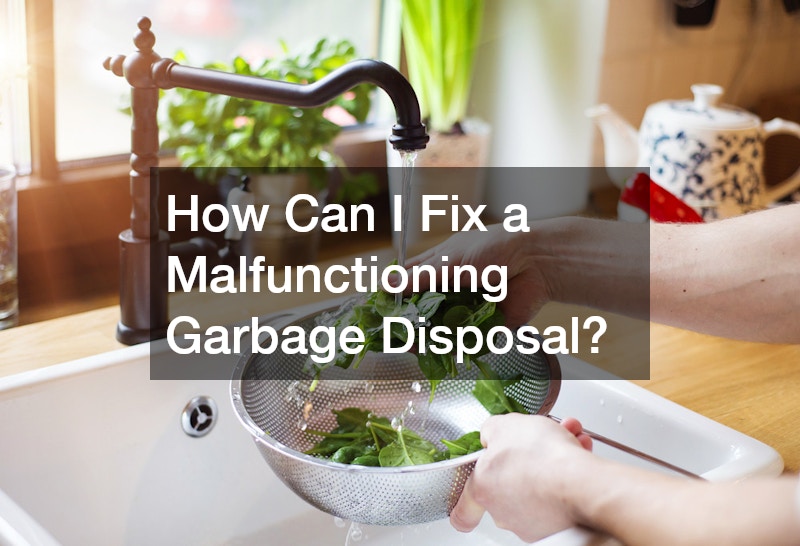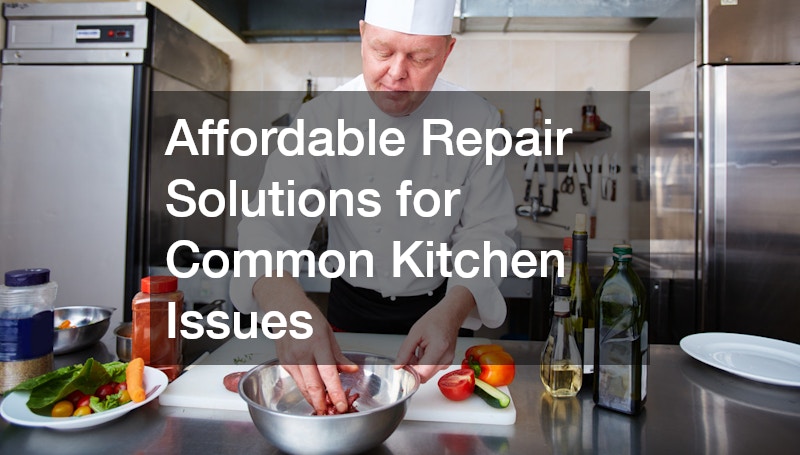Every kitchen experiences wear and tear over time, from leaky faucets to clogged sinks, malfunctioning garbage disposals, or broken cabinet doors. Addressing these problems promptly can prevent more significant damage and save money in the long run. Many homeowners hesitate to tackle minor issues, thinking professional services are the only solution, but with the right guidance, affordable repair is possible for a wide range of common kitchen problems. By learning basic techniques and knowing when to call a professional, you can maintain a fully functional kitchen without overspending. This article will explore practical solutions to frequent kitchen issues, provide step-by-step instructions for DIY fixes, and explain when to seek help from a qualified service provider. We’ll also touch on how professionals like plumbing services, roofers, chimney cleaners, and commercial carpet cleaning companies can assist in maintaining overall household functionality. These strategies will empower homeowners to make informed decisions and achieve lasting results through affordable repair.
How Do I Fix a Leaky Faucet?

Identify the Cause of the Leak
A leaky faucet is one of the most common household problems, but understanding its source can help you address it efficiently. Leaks often occur due to worn-out washers, damaged O-rings, corroded valve seats, or loose parts. Before attempting any repair, turn off the water supply to prevent flooding. Examine the faucet carefully, noting whether the leak comes from the spout, handle, or base. Some leaks may also indicate a more significant plumbing issue that requires a professional plumbing service. By diagnosing the problem correctly, you save time, reduce frustration, and ensure the repair is effective.
Tools and Materials Needed for Repair
Gathering the right tools is essential for affordable repair. Common items include adjustable wrenches, screwdrivers, replacement washers or cartridges, plumber’s tape, and a small bucket to catch water. For more complicated faucets, you may need specialized tools like a basin wrench. Having all necessary materials at hand avoids interruptions and makes the repair process smoother. While some homeowners might opt for a professional service, learning these basic steps can reduce costs and improve your confidence in managing kitchen maintenance.
What Can I Do if My Kitchen Sink Is Clogged?
Common Causes of Kitchen Sink Clogs
Kitchen sinks often become clogged due to grease buildup, food particles, soap residue, or foreign objects accidentally dropped into the drain. Understanding why your sink is blocked helps determine the most effective solution. Regular maintenance, such as avoiding pouring grease down the drain and using a strainer, can prevent future blockages. In some cases, persistent clogs may require the assistance of a plumbing service to avoid damage to your pipes, while simpler clogs can be handled with DIY methods as part of affordable repair.
DIY Unclogging Methods
For minor clogs, start with basic techniques such as using a plunger, a drain snake, or a combination of baking soda and vinegar. Pour boiling water down the drain to help clear grease and debris. Avoid harsh chemical drain cleaners as they can damage pipes over time. If these methods fail, consulting a plumbing service is a safe next step. By applying these strategies, homeowners can save money and keep their kitchen functioning without resorting immediately to professional help. Incorporating regular cleaning habits alongside these DIY fixes supports ongoing affordable repair.
How Can I Fix a Malfunctioning Garbage Disposal?

Identifying Common Disposal Problems
Garbage disposals may fail due to jams, dull blades, or electrical issues. Signs of malfunction include unusual noises, slow draining, or a unit that won’t turn on. Proper diagnosis is critical, as ignoring these issues can lead to more extensive plumbing problems. While some repairs can be handled at home, severe issues may require a licensed plumbing service to ensure safety and compliance with local codes. Recognizing the problem early allows for affordable repair before the need for costly replacements arises.
It’s also worth noting that some disposal problems stem from improper use. Avoid putting fibrous vegetables, large bones, coffee grounds, or grease down the disposal, as these commonly cause clogs or motor strain. By understanding what your disposal can and cannot handle, you reduce the likelihood of recurring issues. Recognizing the problem early allows for affordable repair before the need for costly replacements arises, and staying on top of routine maintenance helps extend the unit’s lifespan. Regularly flushing the disposal with hot water and occasional citrus peels not only keeps odors at bay but also prevents minor debris buildup that could lead to jams.
Step-by-Step Repair Guide
Begin by turning off the power at the circuit breaker to avoid accidents. Use a hex wrench to manually turn the disposal’s motor from below, loosening jams. Remove any trapped debris with tongs, never your hands. For clogs or minor electrical issues, resetting the unit using the reset button often solves the problem. Keep a set of essential tools on hand to streamline future repairs. Following these steps allows homeowners to restore functionality safely, making affordable repair both practical and achievable without professional intervention.
How Do I Repair a Broken Kitchen Cabinet Door?
Assessing the Damage
Before starting repairs, examine the cabinet door carefully to identify cracks, warped wood, loose hinges, or broken panels. Determining the extent of the damage ensures that your repair method matches the problem. For minor hinge adjustments or nail replacements, you can complete the task yourself as part of an affordable repair strategy. Severe damage may require consulting a kitchen remodeler or contractor for guidance to maintain structural integrity and aesthetics.
If damage is more severe, consulting a kitchen remodeler or contractor may be necessary. They can recommend whether replacing the door entirely or reinforcing it is the most cost-effective solution. Paying attention to details such as door alignment and fit not only improves functionality but also helps maintain a consistent kitchen aesthetic. Proper assessment prevents repeated repairs and ensures the effort you invest now is truly a long-term affordable repair solution.
Repair Techniques for Different Types of Damage
Small cracks can often be repaired using wood filler or glue, followed by sanding and painting to match the existing finish. Loose hinges can be tightened with a screwdriver or replaced entirely. For more extensive damage, consider replacing the door with a pre-made option that fits your kitchen style. Whether you choose DIY methods or professional assistance, applying appropriate repair techniques maintains both functionality and appearance. Combining these solutions with routine maintenance, such as regular cleaning, helps ensure long-term durability as part of affordable repair.
In addition to repair, implementing a routine maintenance schedule can prevent further problems. Check doors regularly for loose screws, ensure hinges are lubricated, and keep cabinet surfaces clean and dry. Whether you choose DIY methods or professional assistance, applying these repair techniques maintains both functionality and appearance. Combining these solutions with regular cleaning and preventive measures helps ensure long-term durability as part of affordable repair, saving both money and stress in the years ahead.
What Should I Do if My Kitchen Appliances Won’t Start?

Common Appliance Issues and Their Solutions
Kitchen appliances can fail for a variety of reasons, from electrical issues to worn-out components. Common problems include tripped circuit breakers, faulty cords, or internal malfunctions. Before calling a professional, check the power source, reset breakers, and inspect connections. Small issues like a loose plug or a blown fuse can often be fixed quickly and inexpensively. For more complex repairs, affordable repair may still involve a professional appliance technician, but knowing what to inspect beforehand can save both time and money.
When to Call a Professional
If basic troubleshooting does not resolve the issue, it’s time to seek professional help. A licensed technician can safely diagnose electrical problems, replace damaged parts, and ensure your appliances meet safety standards. Professional services can include plumbing service for appliances like dishwashers or ice makers that connect to water lines. By knowing when to call an expert, homeowners can prevent further damage and keep repair costs manageable. Combining DIY solutions with professional intervention where necessary ensures ongoing affordable repair and appliance longevity.
How Do I Clean and Maintain My Kitchen Tile Grout?
Effective Cleaning Methods
Tile grout in the kitchen can accumulate dirt, grease, and stains, affecting both appearance and hygiene. Simple cleaning solutions like baking soda and vinegar, hydrogen peroxide, or mild detergents can effectively lift grime. Use a small brush to scrub grout lines thoroughly, reaching corners and crevices where dirt often collects. Regular maintenance reduces the need for expensive grout replacements, making this a practical approach for affordable repair. For larger or stubborn areas, commercial carpet cleaning companies or specialized cleaning services may offer targeted solutions for tile and grout maintenance.
Preventative Measures for Future Maintenance
Preventing grout from becoming heavily stained begins with regular cleaning and sealing. Apply a grout sealer every few months to protect against moisture and discoloration. Avoid using abrasive cleaners that can damage the surface. Keeping the area dry and wiping up spills promptly ensures long-term cleanliness. Implementing these preventative measures alongside periodic professional cleaning helps maintain a fresh and functional kitchen, combining DIY affordability with expert results for ongoing affordable repair.
How Can I Address Kitchen Odors?

Common Sources of Kitchen Odors
Kitchen odors often originate from food scraps, garbage disposals, or improper cleaning routines. Moisture in sinks, trash bins, and under cabinets can also lead to unpleasant smells. Identifying the source is the first step in eliminating odors effectively. In some cases, chimney cleaners or plumbing services may help address underlying issues that contribute to lingering smells. Recognizing the root cause allows homeowners to tackle problems directly, reducing unnecessary expenses and supporting long-term affordable repair.
Natural Odor Removal Solutions
Several natural remedies can neutralize kitchen odors without costly products. Baking soda absorbs unwanted smells, while vinegar or lemon juice can disinfect and freshen surfaces. For persistent odors, clean drains thoroughly and consider using a garbage disposal cleaning product to maintain hygiene. Regular maintenance, combined with these natural solutions, ensures a pleasant-smelling kitchen without relying heavily on professional services. Applying these methods consistently is a cornerstone of affordable repair, keeping your kitchen environment healthy and inviting.
What Should I Do if My Kitchen Lighting Is Inadequate?
Identifying the Issue
Poor lighting can hinder cooking, cleaning, and overall functionality in the kitchen. Assess whether the issue lies in insufficient bulbs, outdated fixtures, or poor placement of lighting sources. Sometimes, simply replacing a dim bulb or repositioning a fixture resolves the problem. In other cases, consulting with electricians or general contractors may be necessary, particularly if wiring updates or more complex installations are required. Identifying the root cause ensures an effective solution and prevents unnecessary expenditure.
Upgrading Your Kitchen Lighting Affordably
Improving kitchen lighting doesn’t have to be expensive. LED bulbs, under-cabinet lights, and energy-efficient fixtures can brighten your space while keeping costs low. Choose fixtures that complement your kitchen style while providing practical illumination for work areas. Combining DIY installation with occasional professional help, such as minor electrical adjustments, allows homeowners to achieve effective results without exceeding budget limits. These strategies support ongoing affordable repair, maintaining both functionality and ambiance in your kitchen.
How Roofing Impacts Kitchen Renovations
The Importance of Roof Integrity During Renovations
Roofing plays a critical role in any kitchen renovation. A damaged or leaking roof can lead to water intrusion, structural damage, and mold growth, which can compromise cabinetry, flooring, and appliances. Before starting a major remodel, it’s essential to assess your roof’s condition. Hiring experienced roofers or a reputable roofing company can ensure your roof is stable, preventing unexpected repair costs during your renovation. Regular roof inspections and timely roof repair can protect your kitchen investment, maintain safety, and reduce long-term maintenance needs.
Coordinating Roof Work With Kitchen Remodels
During a kitchen renovation, coordinating with roofing contractors can streamline the process and avoid delays. Roofing installation or roof replacement may involve temporary removal of shingles, flashing, or gutters, which could expose parts of your kitchen to dust or debris if not properly managed. Discuss your kitchen project timeline with your roofing company so they can schedule roof repairs or replacements in a way that minimizes disruption. Choosing qualified roofers and professional roofing contractors ensures that any roof repair or roofing installation meets quality standards, protecting your home and complementing your kitchen remodel. Addressing roofing needs proactively is a key element of affordable repair and a successful renovation.
Maintaining a functional and comfortable kitchen doesn’t have to be a costly endeavor. By addressing common problems like leaky faucets, clogged sinks, malfunctioning garbage disposals, broken cabinet doors, and inadequate lighting promptly, homeowners can implement practical solutions that save both time and money. Affordable repair is achievable through a mix of DIY fixes, preventive maintenance, and selective professional assistance. Whether you choose to clean grout with natural products, replace damaged hinges, or consult a plumbing service or roofing contractor for related home maintenance, the key is to tackle issues early and consistently. Incorporating strategies from commercial carpet cleaning companies, chimney cleaners, roofers, and other professionals when needed ensures your kitchen remains functional and aesthetically pleasing. Ultimately, adopting these techniques not only extends the lifespan of your appliances and fixtures but also reinforces the value of affordable repair as a practical approach to everyday household management. With these tips, your kitchen can remain an efficient, safe, and welcoming space for cooking, gathering, and daily living.
